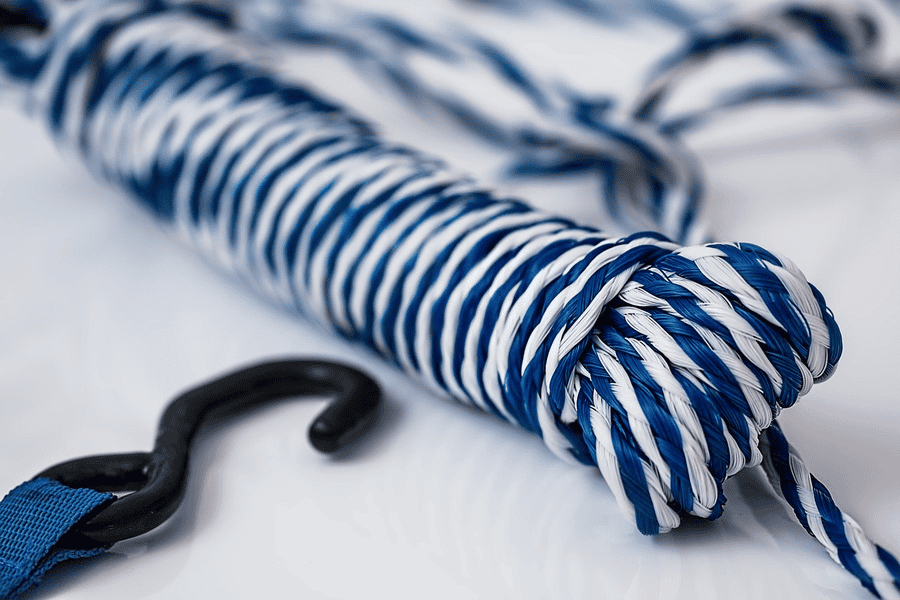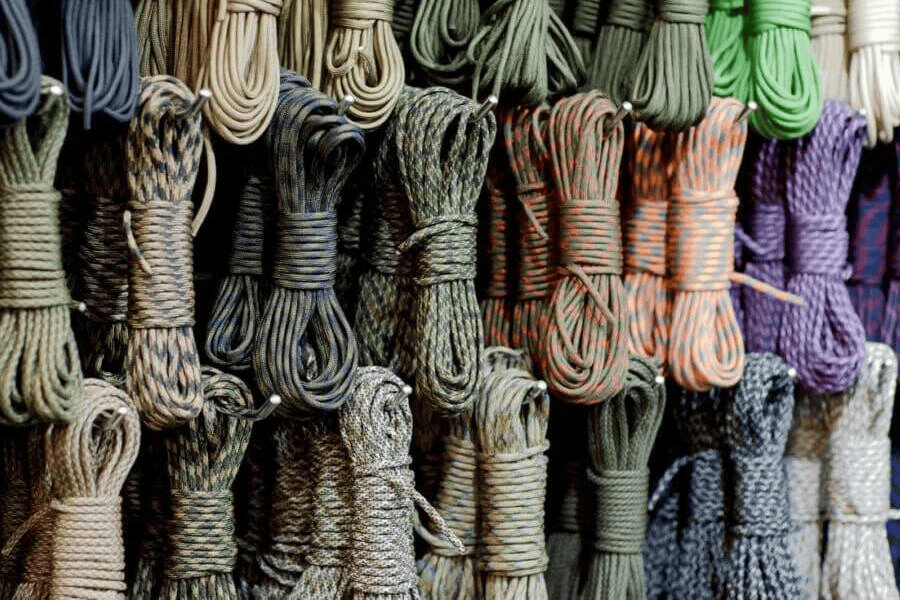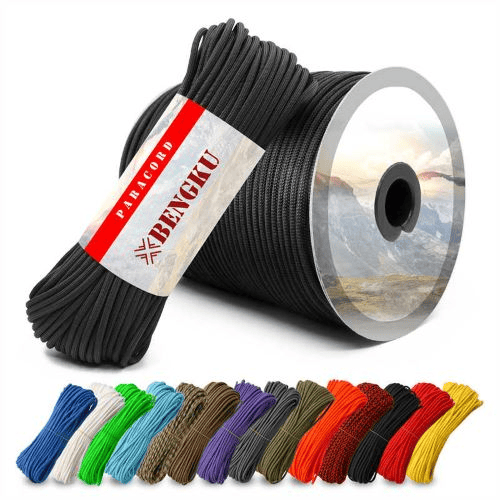Parachute cord, commonly known as 550 paracord, is a versatile and durable type of rope used in survival situations, outdoor activities, and crafting projects. A common question is whether it can get wet and still maintain its strength and functionality. Understanding how this cord reacts to water exposure is crucial for making informed decisions about its use in various environments. In this article, we will explore the effects of moisture on paracord, its water resistance properties, and best practices for maintaining its durability when exposed to wet conditions.

What Happens When 550 Paracord Gets Wet?
When 550 paracord gets wet, it undergoes a few changes, but it largely retains its useful properties. Understanding these changes is important for ensuring that you can rely on your 550 paracord in various conditions.
Water Absorption and Weight
When exposed to water, 550 paracord absorbs a small amount of moisture, which can slightly increase its weight. However, this increase is minimal and does not significantly impact its overall performance.
- Minimal Swelling: Unlike some natural fibers, 550 paracord does not swell much when wet. This means it maintains its diameter and does not become bulky or hard to handle.
- Quick Drying: Paracord dries relatively quickly compared to other materials, reducing the time it remains heavy and waterlogged.
Strength and Durability
One of the key features of paracord is its strength, which remains largely unaffected by water.
- Consistent Strength: Even when wet, paracord maintains most of its tensile strength. This makes it reliable for tasks that require holding weight or withstanding tension.
- Abrasion Resistance: Wet conditions do not significantly compromise the abrasion resistance of paracord. It continues to perform well in rough and demanding environments.
Flexibility and Handling
Paracord remains flexible and easy to handle even when it is wet.
- Maintained Flexibility: The cord does not become stiff or brittle when exposed to moisture, ensuring it remains easy to knot, weave, and manipulate.
- Secure Knots: Knots tied with wet paracord tend to hold securely, which is crucial for tasks that depend on reliable knots and bindings.
Potential Issues
While paracord performs well in wet conditions, there are a few considerations to keep in mind.
- Mildew and Mold: Prolonged exposure to moisture can lead to mildew or mold growth, especially if the cord is stored damp. To prevent this, always dry your paracord thoroughly before storing it.
- Saltwater Exposure: If used in saltwater environments, paracord should be rinsed with fresh water afterward to remove salt deposits, which can degrade the material over time.
By understanding the sturdiness of 550 paracord, users can appreciate its value in a wide range of applications. Its impressive tensile strength, durability, and versatility make it an essential tool for anyone who needs a reliable, strong, and multifunctional cord. Whether in survival situations, outdoor activities, or everyday tasks, 550 paracord proves to be a resilient and indispensable resource.
550 Paracord is Very Sturdy
550 paracord, known for its impressive strength and versatility, is a popular choice for many outdoor and survival enthusiasts. Its sturdiness makes it an essential tool in a wide range of applications, from emergency situations to everyday use.
Tensile Strength
One of the defining features of this paracord is its high tensile strength. Rated at 550 pounds, it can handle significant weight and pressure without breaking.
- Load Bearing: This strength makes it ideal for tasks that require heavy lifting or support, such as hoisting gear, securing loads, or creating makeshift harnesses.
- Reliable Under Stress: The ability to withstand substantial stress without snapping ensures that it remains reliable in critical situations where failure is not an option.
Durability
550 paracord is designed to endure harsh conditions, making it highly durable and long-lasting.
- Abrasion Resistance: The outer sheath of the cord is woven tightly to resist wear and tear, even when rubbed against rough surfaces. This abrasion resistance ensures that the cord remains intact and functional over time.
- Environmental Resilience: This paracord can withstand various environmental factors such as UV radiation, moisture, and extreme temperatures. This resilience makes it suitable for prolonged outdoor use in diverse climates.
Versatility
The sturdiness of this paracord contributes to its versatility, allowing it to be used in numerous ways.
- Survival Situations: In survival scenarios, it can be used to build shelters, create snares for hunting, or make fire-starting bows. Its strength and durability are crucial for these life-saving applications.
- Outdoor Activities: For campers, hikers, and climbers, 550 paracord is invaluable for tasks like setting up tents, securing backpacks, and assisting in descents. Its robust nature ensures safety and reliability during outdoor adventures.
- Crafting and Repairs: The strength of this paracord makes it a popular choice for crafting durable items such as bracelets, keychains, and belts. It is also handy for repairing gear, such as replacing broken shoelaces or fixing damaged equipment.
Structural Integrity
The construction of 550 paracord contributes significantly to its sturdiness.
- Inner Strands: Inside the outer sheath, this cord typically contains seven to nine inner strands, each made of two-ply nylon. These inner strands add to the overall strength and can be used individually for finer tasks.
- Sheath and Core: The combination of a strong outer sheath and a flexible core provides both strength and flexibility. This dual-layer construction allows the cord to handle various tasks without compromising its integrity.
Safety
Using this paracord enhances safety in many activities due to its dependable strength and durability.
- Emergency Rope: In emergencies, it can be used as an emergency rope for rescue operations, creating safe lines for crossing difficult terrain, or improvising safety harnesses.
- Reliable Knots: The cord holds knots well, ensuring that once tied, they remain secure. This reliability is essential in situations where a failing knot could lead to dangerous consequences.
By understanding the sturdiness of 550 paracord, users can appreciate its value in a wide range of applications. Its impressive tensile strength, durability, and versatility make it an essential tool for anyone who needs a reliable, strong, and multifunctional cord. Whether in survival situations, outdoor activities, or everyday tasks, 550 paracord proves to be a resilient and indispensable resource.
Are There Special Boating Paracords?
For boating enthusiasts and professionals, having the right type of cord is crucial for safety and efficiency on the water. While standard paracord is versatile and durable, special boating paracords are designed to meet the unique demands of marine environments. These specialized paracords offer enhanced features that make them particularly well-suited for boating applications.
Enhanced UV Resistance
Boating paracords are often treated or constructed with materials that provide superior resistance to ultraviolet (UV) rays.
- Prolonged Sun Exposure: Regular paracord can degrade over time when exposed to constant sunlight. Boating paracords, however, are designed to withstand prolonged UV exposure, maintaining their strength and flexibility.
- Color Retention: UV-resistant paracords also retain their color longer, which is beneficial for both aesthetics and safety, as brightly colored ropes are easier to spot on the water.
Improved Water Resistance
Boating paracords are specifically engineered to perform well in wet conditions.
- Minimal Water Absorption: These cords absorb very little water, which prevents them from becoming heavy and waterlogged. This ensures they remain easy to handle even after prolonged exposure to water.
- Quick Drying: The materials used in boating paracords allow for quick drying, reducing the risk of mold and mildew growth. This is particularly important for ropes that are stored on boats and frequently exposed to wet conditions.
Enhanced Durability and Strength
The construction of boating paracords focuses on enhanced durability to withstand the rigors of marine environments.
- Abrasion Resistance: Boating paracords are often made with tightly woven outer sheaths that resist abrasion from rough surfaces and repeated friction. This is crucial for tasks like docking and mooring, where ropes are frequently dragged across surfaces.
- High Tensile Strength: These cords are designed to handle significant loads, making them reliable for securing boats, towing, and other heavy-duty applications on the water.
Floatation
Some boating paracords are designed to float, adding an extra layer of safety.
- Floating Ropes: Floating paracords prevent the rope from sinking if it falls into the water, making it easier to retrieve. This feature is especially useful for rescue operations, securing gear, and ensuring that the rope is not lost overboard.
Versatility in Marine Applications
Special boating paracords are versatile and can be used for a wide range of tasks on the water.
- Mooring and Docking: These cords are ideal for mooring and docking boats, providing secure and reliable lines that can handle the stress of tidal movements and waves.
- Securing Equipment: Boating paracords are perfect for securing equipment on deck, such as life jackets, fishing gear, and other essential items, ensuring they remain in place during rough seas.
- Emergency Situations: In emergencies, specialized paracords can be used for rescue operations, creating safety lines, and even towing smaller vessels.
Maintenance and Care
Proper maintenance and care can extend the life of boating paracords, ensuring they remain reliable and effective.
- Regular Inspections: Regularly inspect boating paracords for signs of wear, fraying, or damage. Early detection of issues can prevent failures in critical situations.
- Cleaning: Rinse the ropes with fresh water after exposure to saltwater to remove salt deposits, which can degrade the material over time.
- Proper Storage: Store boating paracords in a cool, dry place away from direct sunlight when not in use to prevent unnecessary UV exposure and prolong their lifespan.

Best Practices for Using Paracord in Wet Conditions
Using paracord in wet conditions requires certain precautions to maintain its strength and durability. While 550 paracord is resilient and capable of handling moisture, following best practices ensures it remains reliable and extends its lifespan. Here are some key tips for using paracord effectively in wet environments:
Drying Techniques
Proper drying techniques are essential to prevent mold, mildew, and degradation.
- Air Drying: After exposure to water, allow your paracord to air dry completely. Hang it in a well-ventilated area to ensure even drying. Avoid leaving it coiled or bundled up while drying, as this can trap moisture and lead to mold growth.
- Avoiding Direct Heat: Do not use direct heat sources like stoves or dryers to speed up the drying process. High temperatures can weaken the fibers and reduce the cord’s strength. Instead, let it dry naturally at room temperature or outside in the shade.
Storage Tips
Proper storage is crucial to maintaining the quality of your paracord.
- Cool, Dry Place: Store your paracord in a cool, dry place away from direct sunlight. Prolonged exposure to UV rays can degrade the material over time, even if it is UV resistant.
- Away from Chemicals: Keep your paracord away from harsh chemicals and substances that could cause damage. Chemicals can weaken the fibers, making the cord less reliable.
- Organized Storage: Use hooks, bags, or containers to keep your paracord organized and tangle-free. This prevents unnecessary wear and tear when retrieving and using the cord.
Regular Maintenance
Regular maintenance helps identify and address potential issues before they become major problems.
- Inspecting for Damage: Frequently inspect your paracord for signs of wear, fraying, or damage, especially after exposure to water. Look for any weak spots or changes in texture that could indicate compromised strength.
- Cleaning After Use: If your paracord has been exposed to saltwater, rinse it thoroughly with fresh water to remove salt deposits. Salt can accelerate wear and cause the fibers to break down over time. After rinsing, allow the cord to dry completely before storage.
Usage Tips
Using paracord correctly in wet conditions ensures it performs well and remains reliable.
- Avoid Overloading: While 550 paracord is strong, avoid exceeding its weight capacity, especially when it is wet. Excessive weight can stretch or damage the fibers, reducing its effectiveness.
- Secure Knots: Ensure that knots are tied securely and checked regularly. Wet conditions can sometimes cause knots to slip or loosen. Practice tying strong, reliable knots that hold well under tension.
- Routine Checks: When using paracord in prolonged wet conditions, such as during extended camping trips or marine activities, perform routine checks to ensure it remains in good condition. Replace any sections that show significant wear or damage.
Emergency Preparedness
Having a plan for dealing with wet paracord can enhance your readiness in emergency situations.
- Backup Supply: Always carry extra paracord as a backup. In case the primary cord gets too damaged or compromised, having a spare ensures you’re not left without a critical tool.
- Pre-Treated Paracord: Consider using pre-treated paracord that is designed to be more resistant to water and UV damage. These cords are specifically made to handle harsh conditions better than standard paracord.
Let’s Get Your Paracord and Rope Ready
Preparing your paracord and rope for various uses ensures you’re always ready for any situation, whether it’s an outdoor adventure, a DIY project, or an emergency. Here’s how to get your paracord and rope ready, ensuring they are in optimal condition and easily accessible when needed.
Selection and Purchase
The first step in getting your paracord and rope ready is choosing the right type for your needs.
- Determine Your Needs: Identify the primary use for your paracord and rope. For general outdoor activities and emergencies, 550 paracord is a great choice due to its strength and versatility. For specialized uses like boating or climbing, consider ropes specifically designed for those activities.
- Quality Matters: Invest in high-quality paracord and ropes from reputable brands. Quality ropes are made with durable materials and superior construction, ensuring they perform reliably under stress.
- Quantity: Purchase enough paracord and rope to cover all your anticipated needs. It’s always a good idea to have extra on hand for unexpected situations.
Preparation and Cutting
Once you have your paracord and rope, prepare them for immediate use.
- Measure and Cut: Measure the lengths you commonly use and cut your paracord and rope accordingly. For instance, cut sections for specific tasks like tying down tents, creating clotheslines, or securing gear.
- Seal the Ends: After cutting, seal the ends of your paracord and rope to prevent fraying. Use a lighter or heat source to carefully melt the ends of synthetic ropes. For natural fibers, use a knot or whipping technique to secure the ends.
Organizing and Storing
Proper organization and storage make it easy to access your paracord and rope when needed.
- Coiling and Wrapping: Coil your paracord and rope neatly to prevent tangles. Use a figure-eight or over-under coiling method to keep them manageable. Secure the coils with a rubber band or a piece of the same cord.
- Storage Solutions: Store your paracord and rope in a designated space, such as a tool box, storage bin, or hanging hooks. For outdoor activities, keep them in a dedicated bag or pouch that you can easily carry.
- Labeling: Label your different lengths and types of rope for quick identification. This is particularly useful if you have ropes for various specific purposes.
Maintenance and Inspection
Regular maintenance and inspection are crucial for ensuring your paracord and rope remain in good condition.
- Routine Checks: Periodically inspect your paracord and rope for signs of wear, damage, or fraying. Pay special attention to areas that experience the most stress.
- Cleaning: Clean your ropes as needed, especially after exposure to dirt, saltwater, or chemicals. Use mild soap and water for synthetic ropes and ensure they are thoroughly dried before storing.
- Conditioning Natural Fibers: If you use natural fiber ropes, consider conditioning them with oils or waxes to maintain flexibility and strength.
Readiness for Use
Having your paracord and rope ready for immediate use can save time and effort in critical moments.
- Pre-tie Knots and Loops: For frequently used knots and loops, consider pre-tying them on sections of your paracord and rope. This saves time and ensures you have reliable knots ready to go.
- Emergency Kits: Include paracord and rope in your emergency kits for home, car, and outdoor activities. Pack them in a way that they are easily accessible and ready for rapid deployment.
- Training and Practice: Familiarize yourself with various knots, hitches, and uses of paracord and rope. Regular practice ensures you can efficiently and effectively use your rope in any situation.
Customization and Enhancements
Consider customizing your paracord and rope setup to better suit your needs.
- Adding Reflective Elements: For increased visibility in low light conditions, consider adding reflective tape or threads to your paracord and rope.
- Color Coding: Use different colored paracord and ropes for different tasks to easily differentiate them. This can be particularly helpful in complex setups or when multiple people are involved.

FAQ
Q1: Can 550 paracord be used in saltwater environments?
A: Yes, 550 paracord can be used in saltwater environments, but it’s important to rinse it with fresh water afterward to remove salt deposits that can degrade the material over time.
Q2: Does 550 paracord lose its strength when wet?
A: No, 550 paracord retains most of its tensile strength when wet, making it reliable for various tasks even in damp conditions.
Q3: How should I dry 550 paracord after it gets wet?
A: Allow your paracord to air dry in a well-ventilated area. Avoid using direct heat sources like stoves or dryers, as high temperatures can weaken the fibers.
Q4: Can mold and mildew grow on wet paracord?
A: Yes, prolonged exposure to moisture can lead to mold and mildew growth. Ensure your paracord is thoroughly dried before storage to prevent this.
Q5: Is UV-resistant 550 paracord better for outdoor use?
A: Yes, UV-resistant paracord is designed to withstand prolonged sun exposure, making it more durable for outdoor use.
Conclusion
550 paracord is highly resilient and performs well even when exposed to water. Its strength, durability, and versatility make it suitable for various applications, including outdoor activities and emergency situations. By understanding how to properly use and maintain paracord in wet conditions, you can ensure its reliability and longevity. Whether you’re camping, boating, or preparing for emergencies, 550 paracord remains a valuable and dependable tool.

